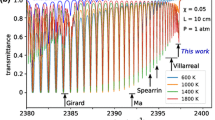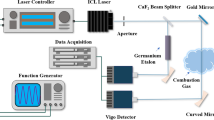Abstract
The feasibility of in situ soft X-ray absorption spectroscopy for imaging carbonaceous species in hydrocarbon flames is demonstrated using synchrotron radiation. Soft X-rays are absorbed by core level electrons in all carbon atoms regardless of their molecular structure. Core electron spectroscopy affords distinct advantages over valence spectroscopy, which forms the basis of traditional laser diagnostic techniques for combustion. In core level spectroscopy, the transition linewidths are predominantly determined by the instrument response function and the decay time of the core–hole, which is on the order of a femtosecond. As a result, soft X-ray absorption measurements can be performed in flames with negligible Doppler and collisional broadening. Core level spectroscopy has the further advantage of measuring all carbonaceous species regardless of molecular structure in the far-edge region, whereas near-edge features are molecule specific. Interferences from non-carbon flame species are unstructured and can be subtracted. In the present study, absorption measurements in the carbon K-edge region are demonstrated in low-pressure (P total = 20–30 Torr) methane jet flames. Two-dimensional imaging of the major carbonaceous species, CH4, CO2, and CO, is accomplished by tuning the synchrotron radiation to the respective carbon K-edge, near-edge X-ray absorption fine structure (NEXAFS) transitions and scanning the burner.





Similar content being viewed by others
References
J.P. Hessler, S. Seifert, R.E. Winans, T.H. Fletcher, Faraday Discuss. 119, 395 (2002)
H. Bluhm et al., J. Electron Spectrosc. 150, 86 (2006)
S.J. Osborne et al., J. Chem. Phys. 102, 7317 (1995)
G.R. Wight, C.E. Brion, J. Electron Spectrosc. 4, 25 (1974)
G.R. Wight, C.E. Brion, J. Electron Spectrosc. 3, 191 (1974)
A.P. Hitchcock, C.E. Brion, J. Electron Spectrosc. 18, 1 (1980)
J. Stöhr, NEXAFS Spectroscopy (Springer, Berlin, 1992)
B.L. Henke, E.M. Gullikson, J.C. Davis, At. Data Nucl. Data Tables 54, 181 (1993)
X. Chao, J.B. Jeffries, R.K. Hanson, Meas. Sci. Technol. 20, 115201 (2009)
R. J. Kee et al., CHEMKIN Collection, Release 4.1.1. (Reaction Design Inc., San Diego, CA, USA, 2007)
The San Diego Mechanism, University of California at San Diego, http://combustion.ucsd.edu (2012)
C.J. Dasch, Appl. Opt. 31, 1146 (1992)
Acknowledgments
This research was funded by the US Department of Energy, Office of Basic Energy Sciences, Division of Chemical Sciences, Geosciences, and Biosciences. Sandia National Laboratories is a multiprogram laboratory operated by Sandia Corporation, a Lockheed Martin Company, for the US Department of Energy under contract DE-AC04-94-AL85000. The Advanced Light Source and beamline 11.0.2 are supported by the Director, Office of Science, Office of Basic Energy Sciences, and by the Division of Chemical Sciences, Geosciences, and Biosciences of the U.S. Department of Energy under Contract No. DE-AC02-05CH11231.
Author information
Authors and Affiliations
Corresponding author
Rights and permissions
About this article
Cite this article
Frank, J.H., Shavorskiy, A., Bluhm, H. et al. In situ soft X-ray absorption spectroscopy of flames. Appl. Phys. B 117, 493–499 (2014). https://doi.org/10.1007/s00340-014-5860-8
Received:
Accepted:
Published:
Issue Date:
DOI: https://doi.org/10.1007/s00340-014-5860-8




